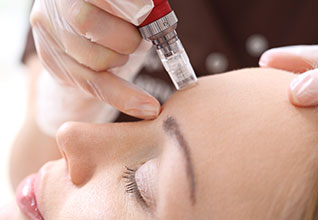DERMA PRICE
Microneedling

Microneedling also known as collagen induction therapy is an aesthetic procedure that stimulates collagen production by promoting the body's natural response to healing.
How Does microneedling Work?
The microneedling procedure uses a device with fine needles to create micro-injuries in the skin, which trigger the body to produce new collagen.
What Skin Conditions Does microneedling Treat?
This skin rejuvenation procedure can smooth lines and wrinkles, improve the appearance of acne and surgical scars, reduce enlarged pores, even out skin discolorations, and fade stretch marks.
Is The Treatment Painful?
Prior to treatment a topical anesthetic is applied to the skin to minimize discomfort during the procedure. After the treatment you may experience mild discomfort, warmth, stinging or burning.
Will There Be Any Downtime Following Treatment?
Following the microneedling procedure your skin will appear red and swollen for up to 2 days. Your skin may also feel tight, dry and sensitive to touch. Mild bruising may be seen as well.
Are There Any Contraindications To Treatment?
You should not have microneedling if you are pregnant, have a history of keloid scars, have taken isotretinoin in the past year or have an active infection or open sore or wound in the area being treated. If you are taking aspirin, blood thinners or certain herbal supplements you may have an increased risk of bruising following microneedling. If you are taking medications that decrease your immunity you may have an increased risk of infection following microneedling.
Do I Need To Do Anything Prior To Treatment?
Microneedling should not be performed on sunburned or irritated skin. You should avoid sun exposure and discontinue topical retinoids (retinol, tretinoin, Retin-A, Renova, Differin, Tazorac, Atralin) for one week prior to a microneedling treatment. You should also avoid waxing and/or the use of chemical depilatories for one week prior to treatment. If you have a history of cold sores your healthcare provider will prescribe an antiviral medication prior to and following the procedure.
Do I Need To Do Anything Following Treatment?
You should not apply makeup or any skincare products to the treatment area in the first 24 hours following your procedure. You should also avoid exposure to the sun or heat and not exercise for 48 hours following treatment. Beginning on the second day following treatment you should apply a physical sunblock with an SPF of 30 or more daily and can resume applying makeup. You should avoid waxing and/or use of chemical depilatories and should not resume the use of a topical retinoid for one week following treatment.
How Many Procedures Are Recommended?
The optimal number of treatments recommended varies depending on your age and the condition of your skin. Most patients require a series of treatments for optimal improvement.
Can I Combine This Procedure With Other Procedures?
During and in the initial month following your procedure it is important to avoid procedures that may increase inflammation in the skin.
Is There Anything I Should Do Following The Procedure To Maximize My Results?
Your healthcare provider will prescribe a skin care regimen to promote cell turnover and collagen production. During this time it is also important that you apply a physical sunblock with an SPF of 30 or more daily. Your healthcare provider may recommend monthly LED photomodulation treatments to decrease inflammation and promote collagen production.

